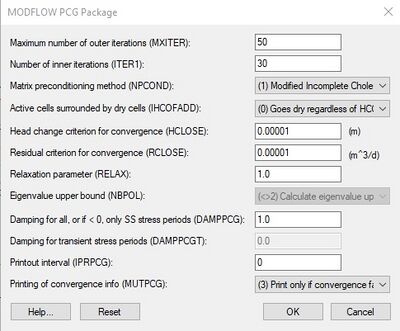GMS:PCG Package: Difference between revisions
From XMS Wiki
Jump to navigationJump to search
m (Jcreer moved page GMS:PCG2 Package to GMS:PCG Package) |
No edit summary Tag: Manual revert |
||
| (21 intermediate revisions by 3 users not shown) | |||
| Line 1: | Line 1: | ||
{{MODFLOW Links}} | {{MODFLOW Links}} | ||
The | The Preconditioned Conjugate Gradient Method (PCG) package is one of the [[GMS:MODFLOW Packages Supported in GMS#Solver Packages|solver packages]] for MODFLOW supported by GMS. | ||
''Maximum outer iterations (MXITER)'' | |||
This value is the maximum iterations, or calls to the solver. For linear problems, this value can be 1, unless more than 50 inner iterations are required, when maximum outer iterations could be as large as 10. For non linear problems, this values should be larger, but generally less than 100. | :This value is the maximum iterations, or calls to the solver. For linear problems, this value can be 1, unless more than 50 inner iterations are required, when maximum outer iterations could be as large as 10. For non linear problems, this values should be larger, but generally less than 100. | ||
''Maximum inner iterations (ITER1)'' | |||
This value is the maximum number of iterations per call to the solver. The default value is 50, and this is sufficient for most problems. | :This value is the maximum number of iterations per call to the solver. The default value is 50, and this is sufficient for most problems. | ||
''Matrix Preconditioning Method (NPCOND)'' | |||
:Use this radio group to choose the matrix conditioning method. The default is to use a modified incomplete cholesky method. | |||
''Active cells surrounded by dry cells (IHCOFADD)'' | |||
:A flag that determines what happens to an active cell that is surrounded by dry cells: | |||
:*0 – Cell converts to dry. This is the default. | |||
:*Not 0 – Cell converts to dry only if HCOF coefficient is 0 (no head-dependent stresses or storage terms) | |||
''Head Change Criterion For Convergence (HCLOSE)'' | |||
When the maximum absolute value of | :When the maximum absolute value of head change from all cells during an iteration is less than or equal to the head change criterion, AND the residual change criterion is met, solver iteration stops. | ||
''Residual Change Criterion For Convergence (RCLOSE)'' | |||
:When the maximum absolute value of residuals from all cells during an iteration is less than or equal to the residual change criterion, AND the head change criterion is met, solver iteration stops. | |||
[[File:MODFLOW- | ''Relaxation Parameter (RELAX)'' | ||
:This value is used if the modified incomplete cholesky method is used. Usually, this value is 1.0, but for some problems a value of 0.99, 0.98, or 0.97 will reduce the number of iterations required for convergence. | |||
''Eigenvalue upper bound (NBPOL)'' | |||
:This value is used if the polynomial method is used. | |||
''Damping for all, or if <0, only SS stress periods (DAMPPCG)'' | |||
:The damping factor. It is typically set equal to one, which indicates no damping. A value less than 1 and greater than 0 causes damping. | |||
''Damping for transient stress periods (DAMPPCGT)'' | |||
:The damping factor for transient stress periods. Only available when when DAMPPCG is specified as a negative value. | |||
''Printout interval (IPRPCG)'' | |||
:The printout interval for the PCG package. If equal to zero, it is changed to 999. The maximum head change (positive or negative) and residual change are printed for each iteration of a time step whenever the time step is an even multiple. This printout also occurs at the end of each stress period regardless of the entered value. | |||
''Printing of convergence info (MUTPCG)'' | |||
:A flag that controls printing of convergence information from the solver: | |||
:*(0) Max head change and residual each iteration | |||
:*(1) Total number of interations | |||
:*(2) No printing | |||
:*(3) Print only if convergence fails | |||
'''Reset''' | |||
:This button will change all options to the default state. | |||
[[File:MODFLOW-PCG.png|thumb|none|left|400 px|The ''MODFLOW PCG Package'' dialog.]] | |||
